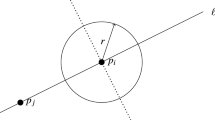Abstract
We consider n-person games in which players are located in some Euclidean space. These locations represent affinity between players. Thus there are two reasons why coalitions might form: (a) the members are close together, and/or (b) there is much to be gained from a coalition. We determine, in such case, which coalitions are more likely to form. We also model how players are likely to move in this space, so that stronger coalitions might form.







Similar content being viewed by others
References
Aleskerov, F., Holler, M. J., & Kamalova, R. (2014). Power distribution in the Weimar Reichstag in 1919–1933. Annals of Operations Research, 215, 25–37.
Algaba, E., Fragnelli, V., & Sánchez-Soriano, J. (Eds.). (2019). Handbook of the Shapley value. Boca Raton: CRC Press.
Aumann, R. J. & Maschler, M. (1964). The bargaining set for cooperative games. In Dresher, Shapley, and Tucker (Eds.),Advances in game theory, annals of mathematics (Vol. 52, pp. 443–476). Princeton University Press.
Banzhaf, J. F. (1965). Weighted voting doesn’t work: A mathematical analysis. Rutgers Law Review, 19, 317–343.
Black, D. (1958). The theory of committees and elections. Cambridge: Cambridge University Press.
Borm, P. E., van den Brink, R., Hendrickx, R., & Owen, G. (2005). “The VL value for network games,” Discussion paper 2005–65. Center for Economic Research: Tilburg University.
Carreras, F., & Owen, G. (1988). Evaluation of the catalonian parliament, 1980–1984. Mathematical Social Sciences, 15, 87–92.
Copeland, A. H. (1951). A reasonable social welfare function (unpublished manuscript).
Downs, A. (1957). An economic theory of democracy. New York: Harper & Row.
Enelow, J. E., & Hinich, M. J. (1984). The spatial theory of voting. Cambridge: Cambridge University Press.
Enelow, J. E., & Hinich, M. J. (Eds.). (1990). Advances in the spatial theory of voting. Cambridge: Cambridge University Press.
Feld, S. L., & Grofman, B. N. (1990). Voting in one’s head as a source of nearly transitive individual preferences over multi-dimensional issues. Annals of Operations Research, 23, 257–263.
Ferejohn, J. A., McKelvey, R. D., & Packel, E. W. (1984). Limiting distributions for continuous state. Markov models. Social Choice and Welfare, 1, 45–67.
Grofman, B. N., Glazer, A., Noviello, N., & Owen, G. (1987). Stability and centrality of legislative choice in the spatial context. American Political Science Review, 81, 539–553.
Harsanyi, J. C. (1957). A bargaining model for the cooperative \(n\)–person game. In Tucker and Luce (Eds.), Contributions to the theory of games IV, annals of mathematics study (Vol. 40, pp. 325–355).
Manuel, C., & Martín, D. (2021). A value for communication situations with players having different bargaining abilities. Annals of Operations Research, 301, 1–22.
McKelvey, R. D. (1986). Covering, dominance, and institution-free properties of social choice. American Journal of Political Science, 30, 283–314.
Myerson, R. B. (1977). Graphs and cooperation in games. Mathematics of Operations Research, 2, 225–229.
Owen, G. (1971). Political games. Naval Research Logistics Quarterly, 18, 345–355.
Owen, G. (1972). Multilinear extensions of games. Management Science, 18, 64–79.
Owen, G. (1975). Multilinear extensions and the Banzhaf value. Naval Research Logistics Quarterly, 22, 741–750.
Owen, G. (1977). Values of games with a priori unions. In Henn and Moeschlin (Eds.), Mathematical economics and game theory (pp. 76–87). Springer, Berlin.
Owen, G. (1986). Values of graph-restricted games. SIAM Journal of Algebraic and Discrete Methods, 7, 210–220.
Owen, G. (1990). Stable outcomes in spatial voting games. Mathematical Social Sciences, 19, 269–279.
Owen, G. (1992). The finagle point for characteristic function games. In Springer Selten (Ed.), Rational interaction (pp. 35–43). Berlin: Verlag.
Owen, G. (2013). Game theory. Bingley: Emerald Group Publishing Limited.
Owen, G., & Shapley, L. S. (1989). Optimal location of candidates in ideological space. International Journal of Game Theory, 18, 339–356.
Peters, H. (2019). Power and the Shapley value. In: Algaba, Fragnelli and Sánchez–Soriano (Eds.), Handbook of the Shapley value (pp. 181–198). Taylor & Francis, CRC Press.
Peters, H., & Zarzuelo, J. M. (2017). An axiomatic characterization of the Owen–Shapley spatial power index. International Journal of Game Theory, 46, 525–545.
Plott, C. R. (1967). A notion of equilibrium and its possibility under majority rule. American Economic Review, 57, 787–806.
Schmeidler, D. (1969). The nucleolus of an \(n\)-person game. SIAM Journal of Applied Mathematics, 17, 1163–1170.
Shapley, L. S. (1953). A value for \(n\)–person games. In Kuhn and Tucker (Eds.), Contributions to the theory of games, II (pp. 307–317).
Shapley, L. S. (1977). A comparison of power indices and a non-symmetric generalization, P-5872. Santa Monica: The RAND Corporation.
Shapley, L. S., & Shubik, M. (1954). A method for evaluating the distribution of power in a committee system. American Political Science Review, 48, 787–792.
von Neumann, J., & Morgenstern, O. (1944). The theory of games and economic behavior. Princeton: Princeton University Press.
Wuffle, A., Feld, S. L., Owen, G., & Grofman, B. N. (1989). Finagle’s law and the finagle point. American Journal of Political Science, 33, 348–375.
Acknowledgements
The authors appreciate the comments of anonymous reviewers.
Author information
Authors and Affiliations
Corresponding author
Additional information
Publisher's Note
Springer Nature remains neutral with regard to jurisdictional claims in published maps and institutional affiliations.
Rights and permissions
About this article
Cite this article
Owen, G., Carreras, F. Spatial games and endogenous coalition formation. Ann Oper Res 318, 1095–1115 (2022). https://doi.org/10.1007/s10479-021-04493-3
Accepted:
Published:
Issue Date:
DOI: https://doi.org/10.1007/s10479-021-04493-3




